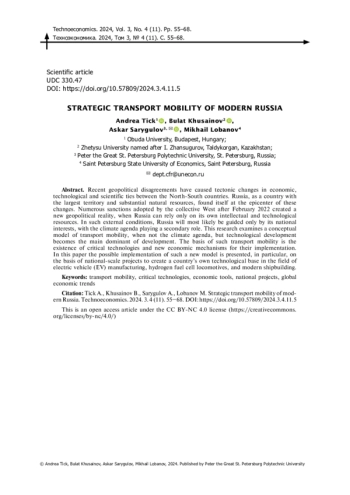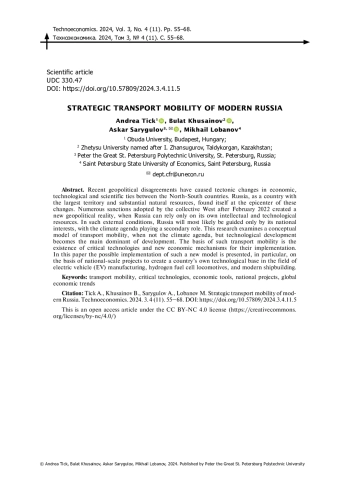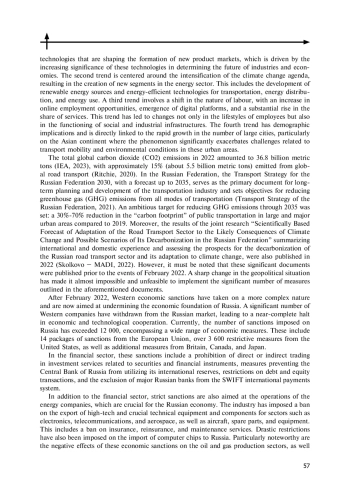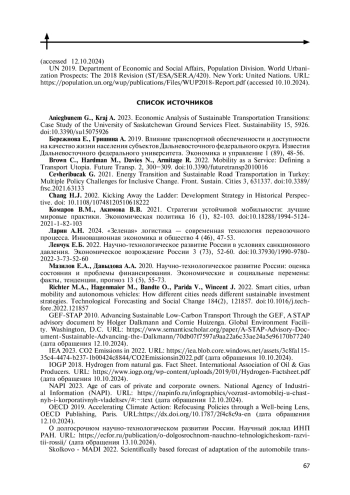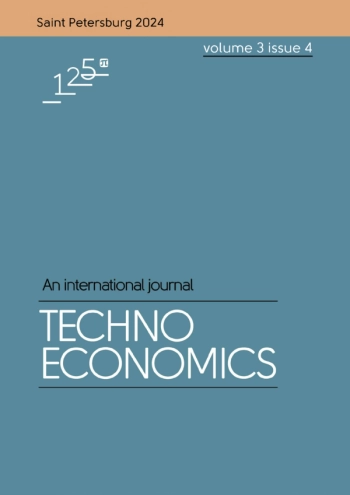Recent geopolitical disagreements have caused tectonic changes in economic, technological and scientific ties between the North-South countries. Russia, as a country with the largest territory and substantial natural resources, found itself at the epicenter of these changes. Numerous sanctions adopted by the collective West after February 2022 created a new geopolitical reality, when Russia can rely only on its own intellectual and technological resources. In such external conditions, Russia will most likely be guided only by its national interests, with the climate agenda playing a secondary role. This research examines a conceptual model of transport mobility, when not the climate agenda, but technological development becomes the main dominant of development. The basis of such transport mobility is the existence of critical technologies and new economic mechanisms for their implementation. In this paper the possible implementation of such a new model is presented, in particular, on the basis of national-scale projects to create a country’s own technological base in the field of electric vehicle (EV) manufacturing, hydrogen fuel cell locomotives, and modern shipbuilding.
Идентификаторы и классификаторы
A key feature of global economic trends over the past five decades has been the exponential growth in energy consumption. Between 1973 and 2022, energy use around the world doubled from 6,210.8 million tons of oil equivalent (Mtoe) to 14,591.1 Mtoe (IEA, 2023). This growth in energy use has been driven not only by the development of industries but also by an expanding range of goods and services, as well as the emergence of new sectors that rely on hightech applications. As further increases in energy consumption are expected to lead to climate change, experts have called for a reassessment of current energy practices. The transition to a new energy paradigm is underway, driven by the widespread adoption of digital technologies kicking off at the turn of the 21st century.
Список литературы
1. Aniegbunem G., Kraj A. 2023. Economic Analysis of Sustainable Transportation Transitions: Case Study of the University of Saskatchewan Ground Services Fleet. Sustainability 15, 5926. DOI: 10.3390/su15075926 EDN: WXXCLB
2. Berezhnova E., Grishina A. 2019. The Impact of Transport Security and Accessibility on the Quality of Life of the Population of the Subjects of the Far Eastern Federal District. News of the Far Eastern Federal University. Economics and Management 1 (89), 48-56.
3. Brown C., Hardman M., Davies N., Armitage R. 2022. Mobility as a Service: Defining a Transport Utopia. Future Transp. 2, 300-309. DOI: 10.3390/futuretransp2010016 EDN: ZTSOLW
4. Cevheribucak G. 2021. Energy Transition and Sustainable Road Transportation in Turkey: Multiple Policy Challenges for Inclusive Change. Front. Sustain. Cities 3, 631337. 10.3389/ frsc.2021.63133. DOI: 10.3389/frsc.2021.63133 EDN: ROZLYY
5. Chang H.J. 2002. Kicking Away the Ladder: Development Strategy in Historical Perspective. DOI: 10.1108/10748120510618222
6. Komarov V., Akimova V. 2021. Strategies for Sustainable Urban Mobility: Analysis of Best Practices. Economic Policy 16(1), 82-103. DOI: 10.18288/1994-5124-2021-1-82-103 EDN: TSCCXK
7. Larin A.N. 2024. “Green” logistics“ - modern technology of transportation process. Innovative economy and society 4 (46), 47-53.
8. Lenchuk E.B. 2022. Scientific and technological development of Russia under sanctions pressure. Economic revival of Russia 3 (73), 52-60. DOI: 10.37930/1990-9780-2022-3-73-52-60 EDN: KUTLDM
9. Mazilov E.A., Davydova A.A. 2020. Scientific and technological development of Russia: assessment of the state and problems of financing. Economic and social changes: facts, trends, forecast 13(5), 55-73. EDN: LONQKB
10. Richter M.A., Hagenmaier M., Bandte O., Parida V., Wincent J. 2022. Smart cities, urban mobility and autonomous vehicles: How different cities needs different sustainable investment strategies. Technological Forecasting and Social Change 184(2), 121857. DOI: 10.1016/j.tech-fore.2022.121857 EDN: TEBBWA
11. GEF-STAP 2010. Advancing Sustainable Low-Carbon Transport Through the GEF, A STAP advisory document by Holger Dalkmann and Cornie Huizenga. Global Environment Facility. Washington, D.C. URL: https://www.semanticscholar.org/paper/A-STAP-Advisory-Doc-ument-Sustainable-Advancing-the-Dalkmann/70db07f7597a9aa22a6c33ae24a5e96170b77240 (accessed 12.10.2024).
12. IEA 2023. CO2 Emissions in 2022. URL: https://iea.blob.core.windows.net/assets/3c8fa115-35c4-4474-b237-1b00424c8844/CO2Emissionsin2022.pdf (accessed 10.10.2024).
13. IOGP 2018. Hydrogen from natural gas. Fact Sheet.International Association of Oil & Gas Producers. URL: https://www.iogp.org/wp-content/uploads/2019/01/Hydrogen-Factsheet.pdf (accessed 10.10.2024).
14. NAPI 2023. Age of cars of private and corporate owners. National Agency of Industrial Information (NAPI). URL: https://napinfo.ru/infographics/vozrast-avtomobilej-u-chast-nyh-i-korporativnyh-vladeltsev/#:~:text (accessed 12.10.2024).
15. OECD 2019. Accelerating Climate Action: Refocusing Policies through a Well-being Lens, OECD Publishing, Paris. URL:10.1787/2f4c8c9a-en (accessed 12.10.2024). DOI: 10.1787/2f4c8c9a-en(accessed12.10.2024)
16. On the long-term scientific and technological development of Russia. Scientific report of the IEF RAS). URL: https://ecfor.ru/publication/o-dolgosrochnom-nauchno-tehnologich-eskom-razvitii-rossii/(accessed 13.10.2024).
17. Skolkovo - MADI 2022. Scientifically based forecast of adaptation of the automobile transport sector to the probable consequences of climate change and possible scenarios for its decarbonization in the Russian Federation. URL: https://esg-library.mgimo.ru/upload/iblock/51d/fij7e-385h3mi8eur6dg5si1hbolq9aeq/SKOLKOVO_EneC_RU_Transport.pdf (accessed 13.10.2024).
18. Transport Strategy of the Russian Federation. 2021. Transport strategy of the Russian Federation until 2030 with a forecast for the period until 2035. Order of the Government of the Russian Federation of November 27, 2021 No. 3363-r. URL: http://static.government.ru/me-dia/files/7enYF2uL5kFZlOOpQhLl0nUT91RjCbeR.pdf (accessed 13.10.2024).
19. UN 2018. Population Facts. Department of Economic and Social Affairs, Population Division. URL: https://population.un.org/wup/publications/Files/WUP2018-PopFacts_2018-1.pdf(accessed 12.10.2024).
20. UN 2019. Department of Economic and Social Affairs, Population Division. World Urbanization Prospects: The 2018 Revision (ST/ESA/SER.A/420). New York: United Nations. URL: https://population.un.org/wup/publications/Files/WUP2018-Report.pdf (accessed 10.10.2024).
Выпуск
Другие статьи выпуска
This article discusses the relevance of mapping as a lean technology employed in the higher education institution in the conditions of digital transformation. The authors emphasize that modern challenges require optimization of business processes, which can be achieved by using lean production methods. In the course of the research a mapping tool was used to analyze and optimize the tracking of student attendance in the structural divisions of the university. This work aims to improve control over student attendance, including several major tasks: assessment of existing lean production tools, application of mapping in attendance tracking, optimization of the current control measures, and development of recommendations for further improvement based on the PDCA cycle. According to the results, mapping and the PDCA cycle proved their efficiency in terms of improving the quality of education in the digital environment.
This research focuses on summarizing statistical data on the total number of students enrolled in Bachelor, Specialist, and Master programs from 2005 to 2021. As a result, a general decrease in the number of students is determined. This trend can be associated with such factors as changes in demography, society, economy, and educational policies. The authors suggest introducing lean technologies into the learning process as a means to increase the number of people involved in education. The evident recent stabilization indicates possible changes in education, highlighting the importance of further research. The integration of lean practices in higher education not only responds to current challenges but also creates conditions for sustainable development of the educational system in the long run.
This research focuses on summarizing statistical data on the total number of students enrolled in Bachelor, Specialist, and Master programs from 2005 to 2021. As a result, a general decrease in the number of students is determined. This trend can be associated with such factors as changes in demography, society, economy, and educational policies. The authors suggest introducing lean technologies into the learning process as a means to increase the number of people involved in education. The evident recent stabilization indicates possible changes in education, highlighting the importance of further research. The integration of lean practices in higher education not only responds to current challenges but also creates conditions for sustainable development of the educational system in the long run.
In recent years artificial intelligence (AI) has become an indispensable tool in digital marketing that is able to simplify human performance and expand business opportunities. This research considers the current AI (artificial intelligence) architectures in digital marketing, reflects on their impact on the activities of companies, and develops a range of optimization recommendations. The authors identify the most important tasks in evaluating existing solutions and their efficiency, as well as assess the possibilities of switching to AI technologies in business. Specific attention is also devoted to the examples of the neural networks implementation in marketing. As a result, the main components of the AI support architecture are identified, together with the further development prospects, with due consideration of current trends and ethical aspects. This research employs the practical achievements of marketing specialists and suggests a range of step-by-step strategies to optimize the business processes.
This article examines the implementation of chatbots in healthcare as a means to automate the patient flow management. The authors analyze the current state of this process, identify operational bottlenecks, and propose chatbot-based solutions for automation of patient registration, document processing, and room allocation. The research method rests on modelling using chatbot technologies and evaluating their overall impact on healthcare efficiency and service delivery. According to the results, the introduction of chatbots reduces administrative workload, facilitates paperwork, and significantly improves service quality. Specific attention is paid to the risks associated with chatbot implementation, such as privacy concerns, and strategies for their mitigation. As a result, the introduction of chatbots proved to have a significant positive impact on operational efficiency, resource optimization, and patient satisfaction in healthcare.
The healthcare industry makes one of the main components of the productive forces of the state. Therefore, the well-being and welfare of the entire society in the future depend on its thriving development. Despite significant accumulated knowledge in medicine, there are still some white spots that are difficult to analyze and predict. The use of artificial intelligence and neural networks in healthcare can significantly expand the analytical apparatus and radically change the existing approaches to scientific research. This article discusses the results of the practical application of artificial intelligence and artificial neural networks in healthcare. The research aims to demonstrate the prospects and advantages of using these information technologies in medicine; identify problems in the implementation of AI technologies in medical practice and offer possible solutions to some of them. The authors provide a comprehensive literature review on the issues of artificial intelligence and neural networks, consider successful examples of the AI use in pharmacology, forecasting, and research of various types of diseases, including cardiovascular system, dermatology, and oncology. A significant part of the research is devoted to ethical and legal concerns, as well as problems associated with the practical use of artificial intelligence. As a result of the research, the authors suggest the models of the IT architecture of a medical information system and data flows, based on the TOGAF standard.
This article discusses the possibility of predicting the values of a series using complex-valued autoregression with an error for short-term forecasting. The authors consider the basic concepts of the function of a complex-valued variable and the model of complexvalued autoregression, together with the results of applying first- and second-order models of complex-valued autoregression with the CARE(p) error to describe and predict the initial series. The results obtained are compared with the first- and second-order autoregression in real numbers. A complex-valued autoregression model with an error showed a more accurate result for short-term forecasting, unlike the autoregression model in real numbers. The authors also conclude that complex-valued autoregression with an error is subject to further investigation in order to find out the prospects of using its imaginary part.
The Russian economy is highly import-dependent, which is also relevant for the enterprises of the science-intensive industry. The later is based on the emerging realities, and strives to develop and introduce a strategy that would allow for the most efficient implementation of the planned import substitution program. In this research the authors have developed a comprehensive mathematical model that takes into account the peculiarities of the local labour and technical capital market, as well as their impact on the production costs of the sciencebased enterprise. The practical application of indicators that can define the current state and the level of dependence of science-based production on foreign raw materials will provide grounds for a revision of the existing development strategy. What is more, it will be possible to take into due consideration the mission of import substitution, based on the available resources of the enterprise and the maximum permissible share of imports in production.
Статистика статьи
Статистика просмотров за 2025 год.
Издательство
- Издательство
- Политех
- Регион
- Россия, Санкт-Петербург
- Почтовый адрес
- 195251, г.Санкт-Петербург, ул. Политехническая, дом 29
- Юр. адрес
- 195251, г Санкт-Петербург, Калининский р-н, ул Политехническая, д 29 литера б
- ФИО
- Рудской Андрей Иванович (РЕКТОР)
- E-mail адрес
- office@spbstu.ru
- Контактный телефон
- +7 (812) 2972077
- Сайт
- https://spbstu.ru
